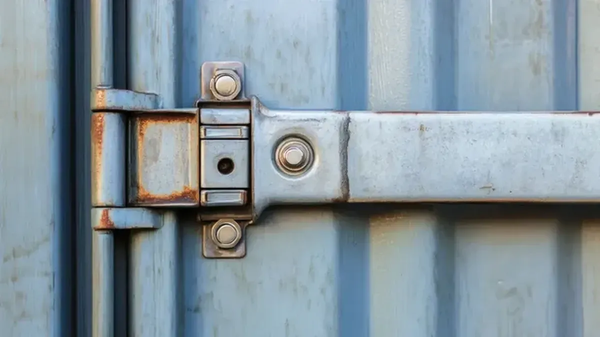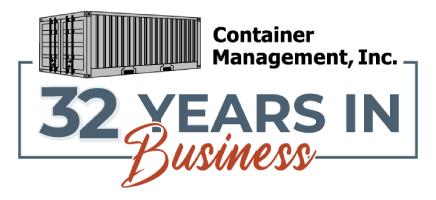How Can I Fix Shipping Container Doors If They Don't Easily Open?
Common Causes of Sticking or Stuck Container Doors
Knowing why your shipping container doors stick is the first step toward effective container door maintenance:
- Rust and Corrosion:
Steel doors and hinges exposed to moisture are susceptible to rust, which can impede movement.
- Debris Build-Up:
Dirt, sand, and debris often collect in container door hinges, locks, or tracks, making doors hard to open.
- Misalignment:
Containers on uneven surfaces or those that have experienced heavy use might develop frame warping or misaligned doors.
- Frozen or Stuck Locks:
Infrequent use or cold weather can cause locks to seize up or seals to freeze.
- Lack of Lubrication:
Hinges and locking mechanisms require regular lubrication to remain operational.
Step-by-Step Solutions for Fixing Shipping Container Doors
1. Inspect the Doors Thoroughly
Start by examining all moving parts:
- Check for visible rust or corrosion.
- Inspect hinges and tracks for debris.
- Use a level to ensure the container is properly placed.
- Operate locks to spot seized mechanisms.
Tip:
A flashlight can help illuminate internal spaces and hinges.
2. Clean the Hinges and Tracks
Cleaning is often an immediate fix for many container door maintenance issue
Steps to Clean Effectively:
- Remove surface dirt with a stiff-bristle brush.
- Use a pressure washer to clear tracks, hinges, and seals. Dry surfaces thoroughly afterward.
- For stubborn grime, apply a degreaser or cleaning solution, scrub gently, and rinse.
Recommended Tools:
- Stiff-bristle brush
- Degreaser
- Pressure washer
3. Address Rust and Corrosion
If rust is present, addressing it promptly is vital:
- Remove rust using a wire brush or sandpaper.
- Apply a rust converter to treat remaining corrosion.
- Protect the area with a rust-resistant primer and paint.

Pro Tip:
Lubricate all treated areas after rust removal.
Recommended Tools:
- Wire brush or sandpaper
- Rust converter
- Primer and paint
Severe corrosion may require professional assistance or part replacement.
4. Lubricate Hinges and Locks
Lubrication is an essential step in ongoing container door maintenance:
- Use a heavy-duty, penetrating lubricant designed for steel hinges.
- Apply to all moving points: hinges, locking rods, and latches.
- Move the doors several times to distribute lubricant evenly.

Product Ideas:
To keep your shipping container hinges operating smoothly and to prevent rust, consider using one of the following lubricants:
- White lithium grease: This heavy-duty lubricant provides a thick, durable layer of protection against moisture, corrosion, and wear, making it ideal for the metal-on-metal contact of container hinges. It's especially well-suited for outdoor use and high-humidity environments, resisting being washed away by rain and moisture.
- Silicone-based spray: Silicone sprays offer excellent friction reduction, prevent squeaks, and resist attracting dust or dirt, which can be particularly beneficial for shipping containers exposed to various environmental conditions. They are also safe for use on plastic and rubber components often found near the hinges.
- WD-40 Specialist Dirt and Dust Resistant Dry Lube PTFE spray: This offers long-lasting lubrication and corrosion protection without leaving an oily residue. It dries quickly, resists dirt, dust, and oil, and is effective in a wide range of temperatures, from -100° F to 500° F. It's safe on metals, plastic, and rubber components.
- GIBBS™ Brand Lubricant: This lubricant is favored for its penetrating and lubricating capabilities, making it a good choice for keeping hinges and locking mechanisms in good condition and preventing rust.
- Penetrating oil: This is useful for cleaning out stubborn dirt and rust that can accumulate within the hinge mechanism. After using a penetrating oil to free up the hinges, you may want to follow up with a grease for longer-lasting lubrication and protection.
- Graphite powder: This dry lubricant is a good choice if you prefer to avoid the mess and potential residue of oil-based or greasy lubricants. It works well in high heat and pressure, and doesn't attract dirt or dust. However, ensure proper application to avoid clogging the mechanism.
Considerations when choosing:
- Environment: For containers in coastal areas or exposed to frequent moisture, prioritize lubricants with strong rust and corrosion protection, such as white lithium grease or silicone-based sprays.
- Temperature: Consider the temperature range in which the container will be used when choosing a lubricant. WD-40 Specialist Dirt and Dust Resistant Dry Lube, for example, is effective in a wide range of temperatures.
- Ease of application: Spray lubricants are generally easier to apply, especially in tight spaces, while grease may require more precise application.
- Durability and longevity: White lithium grease and silicone sprays generally offer longer-lasting lubrication compared to penetrating oils or household alternatives.
5. Fix Any Alignment Issues
If your doors are still difficult to open, misalignment may be the cause:
- Ensure the container sits on a stable, level surface.
- Use a carpenter’s level to check positioning.
- Shim or pack under low corners to re-level.
- For severe warping, seek professional fabricator support.
Tools Suggested:
- Carpenter’s level
- Metal shims
6. Thaw Frozen Doors (If Applicable)
In cold climates, frozen seals may require extra care:
- Pour warm (not boiling) water over frozen areas.
- Use silicone lubricant on door seals after thawing.
Warning:
Never force open stuck container doors when frozen; this risks permanent damage.
7. Replace Worn or Damaged Components
When all else fails, check for parts like:
- Worn hinges
- Damaged seals or gaskets
- Failing locking rods
Replacement parts are available at container suppliers or hardware stores. Mark damaged components to streamline ordering the correct replacements.
Preventive Container Door Maintenance Tips
Maintaining your container doors prevents most future issues. Follow these best practices:
- Clean regularly: Remove debris, clean hinges, and tracks every few months.
- Apply rust protectant: Regularly treat exposed metal for rust prevention.
- Lubricate periodically: Keep all working parts smoothly operable.
- Keep containers level: Re-check ground stability after relocation.
- Prepare for winter: Treat seals with silicone to help prevent freezing.
For more maintenance guidance, visit our Repair Guide to Extending a Shipping Container's Lifespan.
Final Thoughts
Fixing shipping container doors that are stuck or hard to open is often a matter of cleaning, inspecting, and following systematic container door maintenance steps. Regular attention to rust, alignment, and lubrication will prevent most door issues from recurring. For complex problems, including severe frame warping or unmovable rust, consult a professional for safe repairs.





